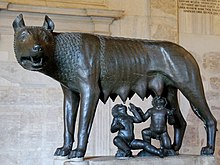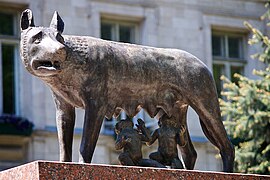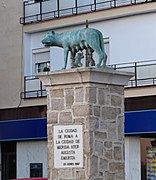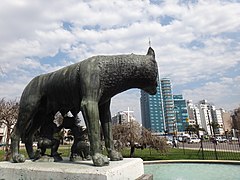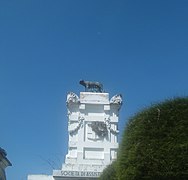
The Quirinal Hill is one of the Seven Hills of Rome, at the north-east of the city center. It is the location of the official residence of the Italian head of state, who resides in the Quirinal Palace; by metonymy "the Quirinal" has come to stand for the Italian president. The Quirinal Palace has an extension of 1.2 million square feet.

The Capitolium or Capitoline Hill, between the Forum and the Campus Martius, is one of the Seven Hills of Rome.

The Capitoline Museums are a group of art and archaeological museums in Piazza del Campidoglio, on top of the Capitoline Hill in Rome, Italy. The historic seats of the museums are Palazzo dei Conservatori and Palazzo Nuovo, facing on the central trapezoidal piazza in a plan conceived by Michelangelo in 1536 and executed over a period of more than 400 years.
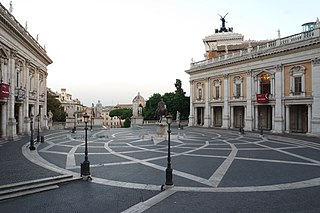
Piazza del Campidoglio is a public square (piazza) on the top of the ancient Capitoline Hill, between the Roman Forum and the Campus Martius in Rome, Italy. The square includes three main buildings, the Palazzo Senatorio also known as the Comune di Roma Capitale, and the two palaces that make up the Capitoline Museums, the Palazzo dei Conservatori and the Palazzo Nuovo, considered to be one of the oldest national museums, founded in 1471 when Pope Sixtus IV donated some of the museum's most impressive statues, the She-wolf, the Spinario, the Camillus and the colossal head of emperor Constantine. Over the centuries the museums' collection has grown to include many of ancient Roman's finest artworks and artifacts. If something was considered too valuable or fragile in Rome and a copy was made in its place for display, the original is likely now on display in the Capitoline Museum.The hilltop square was designed by Michelangelo in the 16th century. at the behest of Pope Paul III.

Piazza del Popolo is a large urban square in Rome. The name in modern Italian literally means "People's Square", but historically it derives from the poplars after which the church of Santa Maria del Popolo, in the northeast corner of the piazza, takes its name.
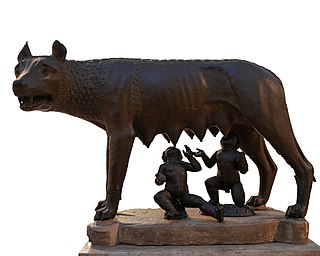
The Capitoline Wolf is a bronze sculpture depicting a scene from the legend of the founding of Rome. The sculpture shows a she-wolf suckling the mythical twin founders of Rome, Romulus and Remus. According to the legend, when King Numitor, grandfather of the twins, was overthrown by his brother Amulius in Alba Longa, the usurper ordered them to be cast into the Tiber River. They were rescued by a she-wolf that cared for them until a herdsman, Faustulus, found and raised them.
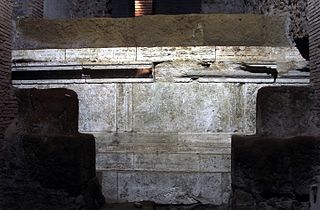
The Temple of Veiovis in ancient Rome was the temple of the god Veiovis, built sometime in the early 1st century BC.

The Capitoline Wolf Statue in Cluj-Napoca, Romania is located on Eroilor Boulevard, in the city centre on the banks of the Someșul Mic River.

The Fontana della Piazza dei Quiriti is a fountain in the Piazza dei Quiriti in Rome, in the middle of the Prati rione. The plaza is named after the inhabitants of the city of Cures, the Curites or later Quirites, namely the Sabines, who became inhabitants and co-founders of Rome. Another theory derives the name from the god Quirinus, a Roman deity.

Marcello Piacentini was an Italian urban theorist and one of the main proponents of Italian Fascist architecture.

The Capitoline Wolf is a monument in Central Chișinău, Moldova. It is located in front of the National History Museum of Moldova.
La lupa is Italian for "the she-wolf", a female wolf.

The Capitoline Wolf Statue is a sculpture of a she-wolf nursing Romulus and Remus in Cincinnati, Ohio, United States. The bronze sculpture on a granite and marble base is located in Eden Park at the Twin Lakes area overlooking the Ohio River. It is a replica of the original Capitoline Wolf in the Musei Capitolini of Rome, Italy.
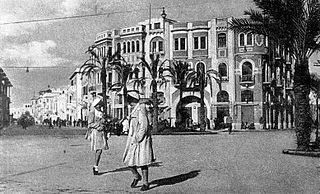
Italian Benghazi was the name used during the Italian colonization of Libya for the port-city of Benghazi in Italian Cyrenaica.
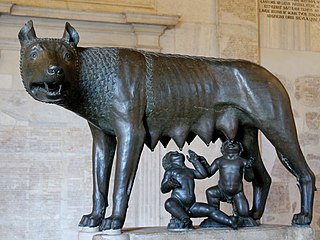
In the Roman foundation myth, a she-wolf was an Italian wolf who nursed and sheltered the twins Romulus and Remus after they were abandoned in the wild by decree of King Amulius of Alba Longa. She cared for the infants at her den, a cave known as the Lupercal, until they were discovered by a shepherd, Faustulus. Romulus would later become the founder and first king of Rome. The image of the she-wolf suckling the twins has been a symbol of Rome since ancient times and is one of the most recognizable icons of ancient mythology.

The following outline is provided as an overview of and topical guide to Rome:
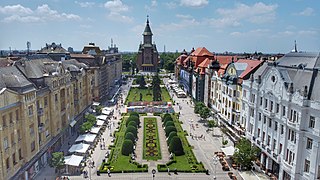
The Victory Square, known until 1990 as the Opera Square, is the central square of Timișoara. It is the place where Timișoara was proclaimed on 20 December 1989 the first city free of communism in Romania. It was a main boulevard, transformed into a square after the closure of the southern side by the construction of the Metropolitan Cathedral. The opposite poles of the square consist of the Opera to the north and the Metropolitan Cathedral to the south. From the Opera to the Cathedral the promenade on the right is called Corso, and the one on the left is called Surogat. Both have protected architectural ensembles of local historical importance.

Capitoline Wolf is a statue located in Timișoara's Victory Square, between the Metropolitan Cathedral and the Palace of Culture. Copy of the famous Capitoline Wolf, the statue was donated by the municipality of Rome in 1926 as a symbol of Latinity that unites the Romanian and Italian peoples. The statue depicts the legend of the founders of Rome, the brothers Romulus and Remus, suckled by a she-wolf. The statue is inscribed in the list of historical monuments with the code TM-III-m-B-06314.

The Capitoline Wolf Statue is a statue located in I.C. Brătianu Boulevard in Bucharest, Romania. It is a historical monument, with the National Register of Historic Monuments in Romania code B-III-m-B-20029.
